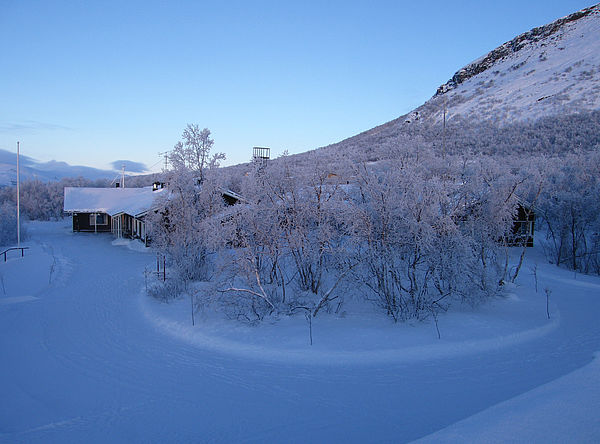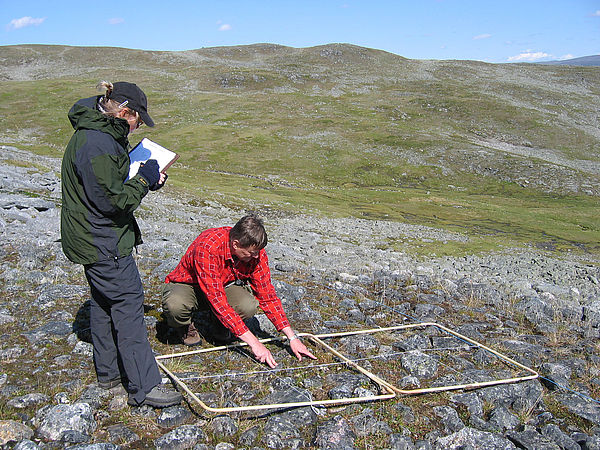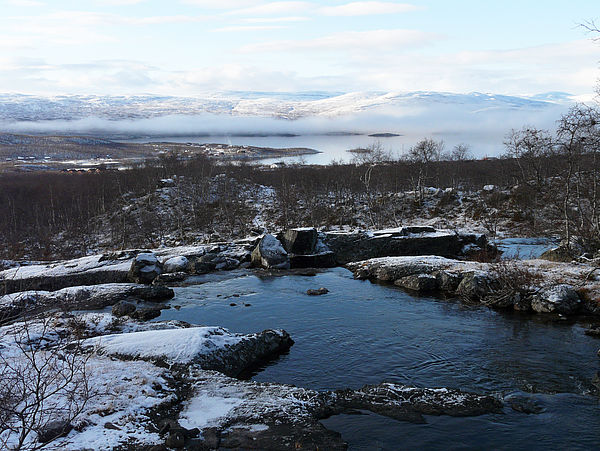
Background
IN0801 | |
Kilpisjärvi Biological Station | |
Sub-Arctic | |
Open | |
Station | |
Finland | |
Station | |
1964 | |
Year-Round |
Introduction
The Kilpisjärvi Biological Station belongs to the University of Helsinki (Faculty of Biological and Environmental Sciences). | |
The station is situated in the community of Enontekiö in the northwestern part of Finnish Lapland (69°03’ N, 20°50’ E) on the shore of Lake Kilpisjärvi at 475 m a.s.l. close to Sweden and Norway. | |
The landscape around the station is dominated by “Fjells” (mountains or high plateaus above the tree line) extending into the Scandinavian mountain range, e.g. Fjell Saana (1029 m a.s.l.) and Pikku-Malla (738 m a.s.l.). The research station lies c.100 km north of continuous coniferous forest and belongs to the sub-alpine birch forest zone, with mountain birch being the dominant plant species. The area is dominated by a wide range of ecosystems from mountain birch forest at low altitude (480-600 m) to alpine tundra (above 600 m). The majority of the area is a mosaic of treeless alpine heath and ponds. Due to the calcareous bedrock, the Kilpisjärvi area is a hotspot for many calcophilic and endangered mountain plant species. As a consequence, the lepidofauna in this area is exceptionally diverse (more than 340 species are recorded). The Kilpisjärvi region is also famous for rich avifauna of northern and mountainous species, like the bluethroat (Luscinia svecica), the ring ouzel (Turdus t | |
The station with its four buildings was officially opened in 1964. In the main building, there are two lecture halls (with space for either 30 or 60 people, one of which also serves as dining room), computer room, library, kitchen, and laboratory facilities. Laboratories have a supply of electricity, gas, compressed air, and running water, and are equipped with refrigerator, ovens, freezers, spectrophotometer, micro- and macro-scales, microscopes, centrifuge, pH- and conductivity meters, thermometers, etc. Also a wide variety of field equipment is available, together with boats and snowmobiles. Ars Bioarctica bioart laboratory is affiliated to the station (http://bioartsociety.fi/ars-bioarctica). The library contains a collection of zoological, botanical, geographical, and statistical handbooks. Telephone, fax, copy machines, and computers with access to internet are provided. WLAN is accessible in the station area. The accommodation capacity is about 50 persons, and meals are served d | |
Widely respected long-term follow-up studies form the core of the scientific activities at the station. The longest observation series (>50 years) are on fluctuations of small rodent densities. Population dynamics of passerines have been monitored since 1957. Long-term research projects also include the periodicity in quality and quantity of vegetation in the mountain region. Effects of environmental changes have been monitored for instance in the International Tundra Experiment (ITEX). The specific long-term studies are backed by more extensive studies on climate, vegetation, soils, rodents, birds, predators, etc. Limnology is a rising branch of research. Lately research activities have extended from animal and botanical ecology to hydrobiological and paleolimnological research. Projects such as MOLAR, CHILL, LAPBIAT, and SCANNET have been carried out in Kilpisjärvi in addition to regular studies on geography and geophysics. The Kilpisjärvi Biological Station is the Finnish representa | |
Reindeer husbandry, tourism, and research dominate in the area. Recent construction and development plans in the village may pose a threat for the future of some of the long-term studies. | |
The station is easily accessible by air or bus (via Rovaniemi). Within a two hours car journey there are two airports, Enontekiö in Finland and Tromsø in Norway. Also Kiruna airport in Sweden is relatively close to the station. |
Operator
University of Helsinki | |
Government | |
Kilpisjärvi Biological Station | |
bio-kilpis@helsinki.fi |
Data Source
Partner Institution
Yes |
Location
IN0801 | |
69° 3' 0'' N | |
20° 50' 0'' E | |
European Arctic | |
480 | |
473 | |
1025 | |
0 | |
150 | |
280 | |
0 | |
Ice-free ground |
Climate
Sporadic | |
Sub-Arctic | |
Snow and Rain | |
447 | |
3.6 | |
144 | |
NW | |
-2.23 | |
-13 | |
11 | |
None | |
June | |
June; July; August; September |
Features
Lake; Permanent snowpatches; Rivers; Shoreline; Tree line; Valley; Other | |
Peatlands; Wetlands; Palsa mires; Deciduous forest; Evergreen forest; Human settlements or resource use in the area |
Disciplines
Climatology; Climate change; Environmental sciences; Geocryology; Geodesy; Geology; Geomorphology; Geophysics and seismology; GIS; Hydrology; Limnology; Mapping; Marine biology; Paleoecology; Paleolimnology; Pollution; Sedimentology; Social science; Terrestrial biology | |
Land use; Community based monitoring, Citizen Science |
Human Activities
Yes | |
Sami reindeer herding | |
Yes | |
Yes | |
Yes | |
Yes |
Infrastructure
IN0801 | |
1760 | |
150 | |
Biology | |
1 | |
200 | |
57 | |
Yes | |
Yes | |
Fossil fuel | |
230 | |
24 |
Staff Capacity
10 | |
3 | |
8 | |
2 | |
8 | |
0 |
Scientific Equipment
Plants, birds, small rodents |
Medical Facilities
No | |
0 | |
0 | |
160 | |
0 | |
0 | |
0 | |
0 | |
Yes |
Vehicles
Cars, boats, snowmobile |
Workshop facilities
ICTS (Staff available to assit with constructions) |
Communications
Computer; E-mail; Fax; Internet; Printer; Scanner; Telephone |
Access
IN0801 | |
Land |
Aircraft landing facilities
0 | |
0 | |
0 | |
Yes |
Transport and freight
Car | |
0 | |
0 |
Access To The Facility
None | |
Permits working in the Malla nature reserve or other protected areas required. |
Pictures
 Kilpisjärvi village overview (Credits: Rauni Partanen) |
 Station in winter (Credits: Oula Kalttopää) |
 Botanical field work (Credits: Lauri Järvinen) |
 Dining room (Credits: Rauni Partanen) |
 Reindeer on the road (Credits: Antero Järvinen) |
 Students in field (Credits: Antero Järvinen) |
 Winter landscape (Credits: Antero Järvinen) |
